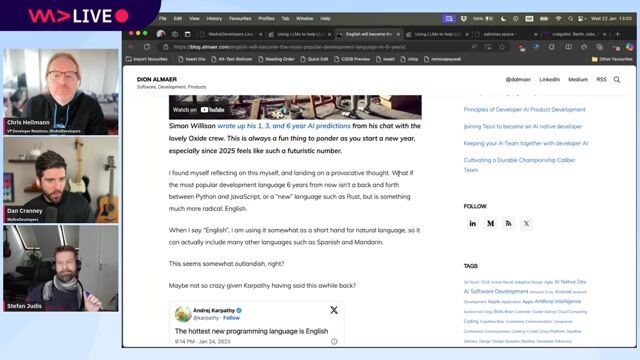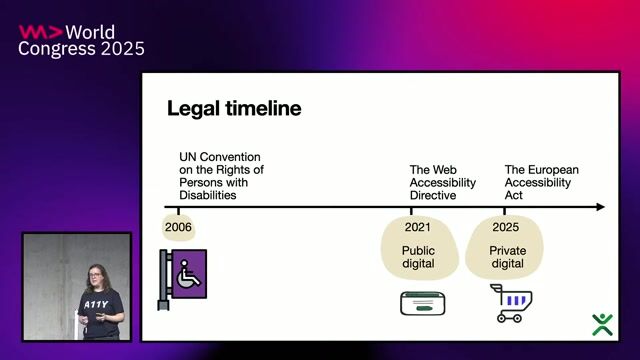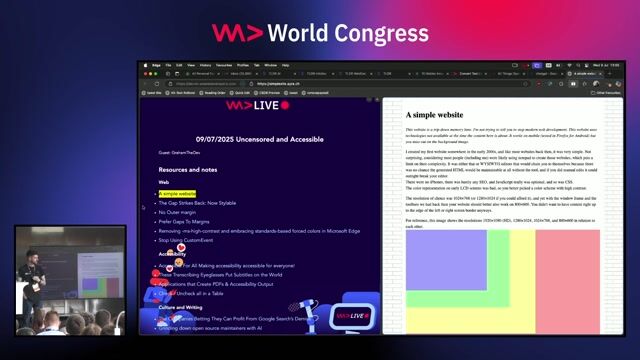Chris Heilmann & Daniel Cranney & Emma Dawson
WeAreDevelopers LIVE - Gaps in CSS, EU Accessibility Act and more!
#1about 5 minutes
From teaching to a career in web accessibility
A former teacher explains how adapting lessons for students with diverse needs provided a natural foundation for a career in web accessibility.
#2about 6 minutes
Learning front-end development by recreating existing websites
The "Front End Practice" website offers a practical approach to learning by challenging developers to replicate real-world UIs, which demystifies design and coding techniques.
#3about 3 minutes
Exploring the new CSS proposal for element separators
A new CSS proposal aims to simplify creating separators between elements, eliminating the need for hacky solutions like removing the last border in a list.
#4about 7 minutes
Balancing creative control and usability with CSS form styling
While new CSS form styling capabilities offer more design freedom, they also risk creating inconsistent or inaccessible controls if not used carefully.
#5about 5 minutes
Addressing inconsistent spacing and gaps in CSS layouts
Modern CSS offers multiple ways to handle spacing like margin, padding, and gap, which can lead to confusion and inconsistent layouts.
#6about 7 minutes
Preparing for the upcoming European Accessibility Act
The European Accessibility Act (EAA) will soon require private sector services like e-commerce and banking to meet specific accessibility standards.
#7about 11 minutes
The role and limitations of AI in generating alt text
While AI can help generate alternative text for large image backlogs, it often lacks the contextual understanding that a human editor provides.
#8about 5 minutes
Checking browser and screen reader support for accessibility features
The website a11ysupport.com acts like "Can I Use" for accessibility, showing which ARIA roles and properties are supported across different screen readers and browsers.
#9about 3 minutes
How Safari's `list-style: none` behavior impacts accessibility
Safari's controversial decision to remove list semantics when `list-style: none` is applied forces developers to add `role="list"` to ensure screen readers announce it correctly.
#10about 3 minutes
Building accessible animated accordions with the details element
The native HTML `<details>` and `<summary>` elements provide a semantic and accessible foundation for creating animated accordion components without JavaScript.
#11about 5 minutes
Using fieldset and legend to group related form controls
Wrapping related form inputs like an address block in a `<fieldset>` with a `<legend>` provides essential context that is announced by screen readers for each control.
#12about 2 minutes
A look back at the first registered .com domain name
The very first `.com` domain name was registered in 1985, not for a major tech company, but for a computer manufacturer called Symbolics.
#13about 3 minutes
Final advice for integrating accessibility into your workflow
The most effective way to build accessible products is to consider accessibility from the very beginning of the development process rather than treating it as an afterthought.
Related jobs
Jobs that call for the skills explored in this talk.
Matching moments

1:15:46 MIN
What the European Accessibility Act means for developers
WeAreDevelopers LIVE - Accessibility isn't magic, Longevity, Devrel in times of AI and more

27:17 MIN
The importance of web accessibility as a core developer craft
WAD Live 22/01/2025: Exploring AI, Web Development, and Accessibility in Tech with Stefan Judis

00:15 MIN
Defining web accessibility and its importance for developers
Decoding web accessibility through audit

31:03 MIN
Understanding the upcoming European Accessibility Act
WeAreDeveloper Live: Accessibility in the EU, CSS Gaps and forms with Emma Dawson

52:28 MIN
ARIA usage, web push, and the European Accessibility Act
WeAreDevelopers LIVE - Can AI save Accessibility?; Horrid HTML; The Frontend Treadmill and more

38:02 MIN
Q&A on framework choice and accessibility
Extending HTML with Web Components

41:29 MIN
Discussion on the evolution and future of CSS
What's new in CSS for Designers?

37:18 MIN
Q&A on practical accessibility challenges
Preventing Accessibility Issues Instead Of Fixing Them
Featured Partners
Related Videos
 1:10:08
1:10:08WeAreDeveloper Live: Accessibility in the EU, CSS Gaps and forms with Emma Dawson
Emma Dawson
 1:06:13
1:06:13WeAreDevelopers LIVE - Can AI save Accessibility?; Horrid HTML; The Frontend Treadmill and more
Chris Heilmann & Daniel Cranney & Dirk Ginader
 1:09:45
1:09:45WeAreDevelopers LIVE – Inclusion, Accessibility & Automation
Chris Heilmann, Daniel Cranney & Daniela Kubesch
 1:42:35
1:42:35WeAreDevelopers LIVE - Accessibility isn't magic, Longevity, Devrel in times of AI and more
Chris Heilmann, Daniel Cranney & GrahamTheDev
 1:02:33
1:02:33WeAreDevelopers LIVE - Rendering in the Browser, The State of CSS and Accessibility and more
Chris Heilmann, Daniel Cranney & Elena Torró
 24:30
24:30Oh S***! There's a New Accessibility Law and I'm Not Ready!
Emma Dawson
 38:58
38:58WeAreDevelopers LIVE - Is Software Ever Truly Accessible?
Chris Heilmann, Daniel Cranney & GrahamTheDev
 1:06:20
1:06:20WeAreDevelopers LIVE – Frontend Inspirations, Web Standards and more
Chris Heilmann, Daniel Cranney & Jan Deppisch
Related Articles
View all articles



From learning to earning
Jobs that call for the skills explored in this talk.

Web developer (f/m/d) as parental leave substitution
Agora Think Tanks gGmbH
Berlin, Germany
Intermediate
Senior
PHP
CSS
HTML
JavaScript
TypeScript





Web Developer / Technical Support - Swiftcase
Livepoint Software Solutions Ltd
Heswall, United Kingdom
Remote
€26-32K
PHP
CSS
HTML
+1


Frontend Web Developer - JavaScript | React | Angular | Vue.js | Bootstrap | Tailwind | HTML | CSS
Tech Solutions Gmbh
Berlin, Germany
API
CSS
GIT
HTML
Scrum
+5

Frontend Web Developer - JavaScript | React | Angular | Vue.js | Bootstrap | Tailwind | HTML | CSS
Tech Solutions Gmbh
Brandenburg an der Havel, Germany
API
CSS
GIT
HTML
Scrum
+5